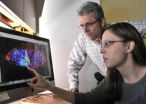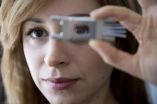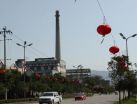(Press-News.org) DALLAS – March 26, 2014 – Just as archeologists try to decipher ancient tablets to discern their meaning, UT Southwestern Medical Center cancer biologists are working to decode the purpose of an ancient gene considered one of the most important in cancer research.
The p53 gene appears to be involved in signaling other cells instrumental in stopping tumor development. But the p53 gene predates cancer, so scientists are uncertain what its original function is.
In trying to unravel the mystery, Dr. John Abrams, Professor of Cell Biology at UT Southwestern, and his team made a crucial new discovery – tying the p53 gene to stem cells. Specifically, his lab found that when cellular damage is present, the gene is hyperactive in stem cells, but not in other cells. The findings suggest p53’s tumor suppression ability may have evolved from its more ancient ability to regulate stem cell growth.
“The discovery was that only the stem cells light up. None of the others do. The exciting implication is that we are able to understand the function of p53 in stem cells,” said Dr. Abrams, Chair of the Genetics and Development program in UT Southwestern’s Graduate School of Biomedical Sciences. “We may, in fact, have some important answers for how p53 suppresses tumors.”
The findings appear online in the journal eLife, a joint initiative of the Howard Hughes Medical Institute, the Max Planck Society, and the Wellcome Trust.
p53 is one of the hardest working and most effective allies in the fight against cancer, said Dr. Abrams. It regulates other genes, marshaling them to carry out an untold number of preemptive attacks and obliterate many pre-cancerous cells before they ever pose a threat. In nearly every case where there’s a tumor, p53 is damaged or deranged, strongly suggesting that it is a tumor suppressant.
Stem cells are one of the body’s most useful cells because of their regenerative capabilities. Stem cells produce daughter cells, one that is a stem cell and another that can become virtually any kind of cell that’s needed, such as a blood cell or a kidney cell. Stem cells have received tremendous attention in cancer research because of the stem cell hypothesis. That hypothesis maintains that malignant tumors are initiated and maintained by a population of tumor cells that have properties similar to adult stem cells.
“What this new finding tells us is that an ancient functionality of p53 was hard-wired into stem cell function,” said Dr. Abrams, senior author. “From the standpoint of trying to decipher cancer biology, that’s a pretty profound observation.”
To study the gene, researchers in Dr. Abrams lab, including Dr. Annika Wylie, postdoctoral research fellow and first author on the paper, developed a transgenic sensor that makes cells glow when they are active in Drosophila, or fruit flies. Other UT Southwestern researchers involved included Dr. Michael Buszczak, Assistant Professor of Molecular Biology.
INFORMATION:
The work was supported by the Cancer Prevention and Research Institute of Texas, the Ellison Foundation, the National Institute of General Medical Sciences, the Welch Foundation, the National Institute of General Medical Sciences, and a Genetic Training Grant.
UT Southwestern’s Harold C. Simmons Comprehensive Cancer Center is the only National Cancer Institute-designated cancer center in North Texas. The center brings innovative cancer care to the region, while fostering groundbreaking basic research that has the potential to improve patient care and prevention of cancer worldwide.
About UT Southwestern Medical Center
UT Southwestern, one of the premier academic medical centers in the nation, integrates pioneering biomedical research with exceptional clinical care and education. The institution's faculty includes many distinguished members, including five who have been awarded Nobel Prizes since 1985. Numbering more than 2,700, the faculty is responsible for groundbreaking medical advances and is committed to translating science-driven research quickly to new clinical treatments. UT Southwestern physicians provide medical care in 40 specialties to nearly 91,000 hospitalized patients and oversee more than 2 million outpatient visits a year.
This news release is available on our home page at utsouthwestern.edu/home/news/index.html
UT Southwestern cancer biologists link tumor suppressor gene to stem cells
2014-03-26
ELSE PRESS RELEASES FROM THIS DATE:
Biological testing tool, ScanDrop, tests in fraction of time and cost of industry standard
2014-03-26
Northeastern University professor of pharmaceutical sciences, Tania Konry, has developed a single instrument that can conduct a wide range of biological scans in a fraction of the time and cost of industry standard equipment. That's because it uses considerably less material and ultra-sensitive detection methods to do the same thing.
Currently, researchers face enormous time constraints and financial hurdles from having to run these analyses on a regular basis. Hundreds of dollars and 24 hours are what's required to scan biological materials for important biomarkers that ...
Natural history must reclaim its place
2014-03-26
Support in developed countries for natural history—the study of the fundamental nature of organisms and how and where they live and interact with their environment—appears to be in steep decline. Yet natural history provides essential knowledge for fields as varied as human health, food security, conservation, land management, and recreation. In the April issue of BioScience, a group of scientists from institutions across North America details examples supporting their conviction that a revitalization of the practice of natural history will provide important benefits for ...
Coal plant closure in China led to improvements in children's health
2014-03-26
Decreased exposure to air pollution in utero is linked with improved childhood developmental scores and higher levels of brain-derived neurotrophic factor (BDNF), a key protein for brain development, according to a study looking at the closure of a coal-burning power plant in China led by researchers at the Columbia Center for Children's Environmental Health at the Mailman School of Public Health.
The study is the first to assess BDNF and cognitive development with respect to prenatal exposure to polycyclic aromatic hydrocarbons (PAH), a component of air pollution commonly ...
Resistance is not futile
2014-03-26
Researchers with the U.S. Department of Energy (DOE)'s Joint BioEnergy Institute (JBEI), a multi-institutional partnership led by Berkeley Lab, have identified the genetic origins of a microbial resistance to ionic liquids and successfully introduced this resistance into a strain of E. coli bacteria for the production of advanced biofuels. The ionic liquid resistance is based on a pair of genes discovered in a bacterium native to a tropical rainforest in Puerto Rico.
"We identified two genes in Enterobacter lignolyticus, a soil bacterium that is tolerant to imidazolium-based ...
NASA catches Gillian as a super-cyclone before quickly dissipating
2014-03-26
VIDEO:
On March 23 when the TRMM satellite passed over Gillian, it was at hurricane-force. TRMM revealed intense storms in a well-defined eye wall producing rain at a rate of over...
Click here for more information.
Tropical Cyclone Gillian was near peak intensity when the Tropical Rainfall Measuring Mission or TRMM satellite passed overhead and saw towering thunderstorms and very heavy rainfall in the storm on March 23. By March 26, Gillian had weakened to a tropical storm and ...
Rice U. study: Don't shop for travel at work
2014-03-26
HOUSTON – (March 26, 2014) –It is probably not a good idea to shop for leisure travel from the office during business hours, according to a new study from Rice University and Iowa State University.
Using data from a major online hotel reservation site, the study examined the quality of the hotel that consumers chose for their vacations and subsequently how satisfied they were with their stay. They found that consumers who traveled farther and made reservations during business hours were more likely to select higher quality hotels but were less satisfied after their stay. ...
Dark energy hides behind phantom fields
2014-03-26
Quintessence and phantom fields, two hypotheses formulated using data from satellites, such as Planck and WMAP, are among the many theories that try to explain the nature of dark energy. Now researchers from Barcelona and Athens suggest that both possibilities are only a mirage in the observations and it is the quantum vacuum which could be behind this energy that moves our universe.
Cosmologists believe that some three quarters of the universe are made up of a mysterious dark energy which would explain its accelerated expansion. The truth is that they do not know what ...
Albert Einstein College of Medicine researchers present at AACR Annual Meeting symposia
2014-03-26
March 26, 2014 – (BRONX, NY) – From uncovering the role nerve cells play in metastasis to identifying new cancer-causing genes, researchers at Albert Einstein College of Medicine of Yeshiva University made notable advances in the understanding and potential treatment of cancer during the past year.
Several Einstein faculty members and students will present their recent research at the American Association for Cancer Research (AACR) Annual Meeting, taking place in San Diego April 5-9, 2014. Among the presentations are those during major and mini symposia:
Gene Regulation ...
Gout isn't always easy to prove: CT scans help catch cases traditional test misses
2014-03-26
Rochester, Minn. — Gout is on the rise among U.S. men and women, and this piercingly painful and most common form of inflammatory arthritis is turning out to be more complicated than had been thought. The standard way to check for gout is by drawing fluid or tissue from an affected joint and looking for uric acid crystals, a test known as a needle aspirate. That usually works, but not always: In a new Mayo Clinic study, X-rays known as dual-energy CT scans found gout in one-third of patients whose aspirates tested negative for the disease. The CT scans allowed rheumatologists ...
Preoperative PET cuts unnecessary lung surgeries in half
2014-03-26
Reston, Va. (March 21, 2012) – New quantitative data suggests that 30 percent of the surgeries performed for non-small cell lung cancer patients in a community-wide clinical study were deemed unnecessary. Additionally, positron emission tomography (PET) was found to reduce unnecessary surgeries by 50 percent, according to research published in the March issue of the Journal of Nuclear Medicine.
PET imaging prior to surgery helps stage a patient's disease by providing functional images of tumors throughout the body, especially areas where cancer has spread, otherwise known ...





